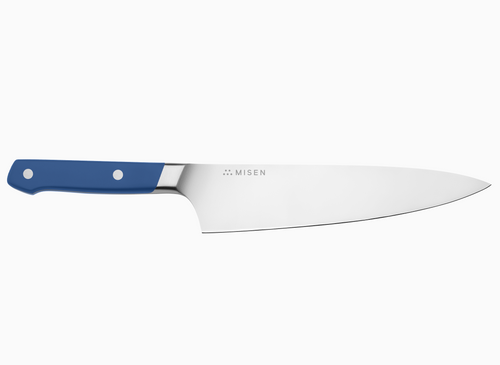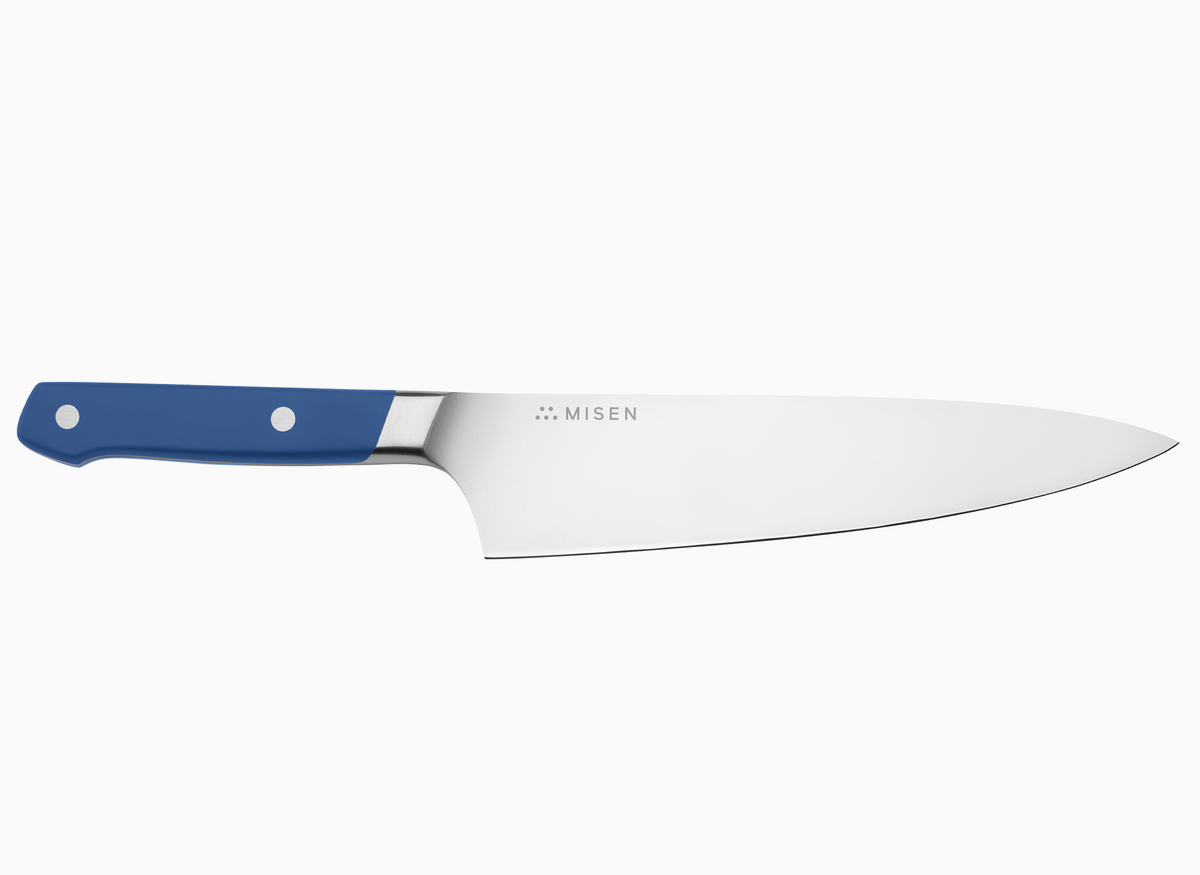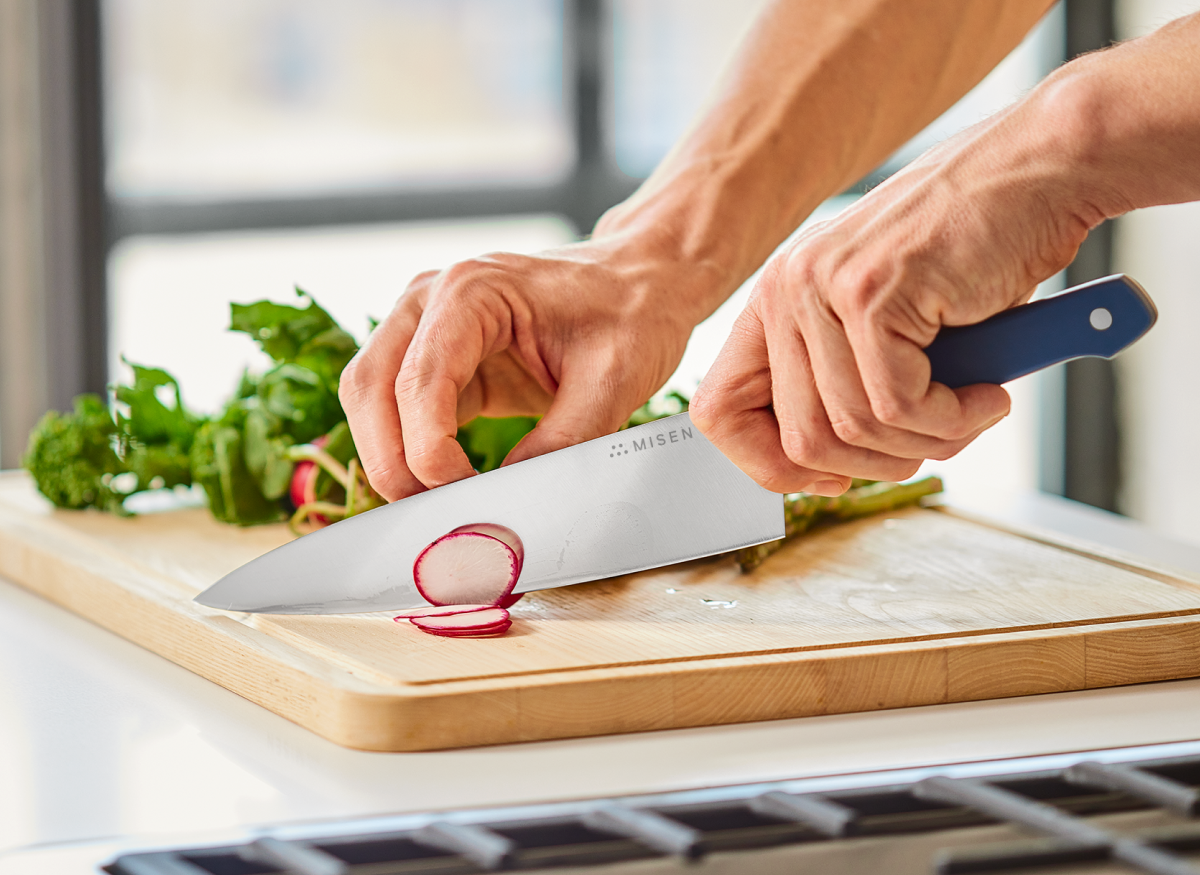The Role of a Kitchen Knife in Culinary Success

A chef's knife is the cornerstone of any kitchen, offering versatility and precision for various culinary tasks. Understanding its anatomy, proper usage, and maintenance is crucial for enhancing cooking efficiency and food quality. This guide explores the essential aspects of kitchen knives, from their historical evolution to advanced cutting techniques, empowering you to elevate your culinary skills.
Understanding the Chef's Knife
Definition and characteristics of a chef's knife
A chef's knife, the quintessential tool in any kitchen, has evolved from its origins as a beef-cutting implement to become the primary utility knife for cooks worldwide. Typically measuring 20 centimeters (8 inches) in length and 4 cm (1½ in.) in width, this versatile blade features a curved edge known as the "belly," which facilitates the rocking motion essential for various cutting techniques[1]. Its design allows for efficient mincing, slicing, and chopping of vegetables, as well as handling meat and disjointing large cuts[2].
The shape of a chef's knife can vary, with French and German styles being the most prominent. The French version features a straighter edge that curves up at the tip, while the German style has a more continuous curve along the cutting edge[3]. This diversity in design caters to different cutting preferences and techniques, allowing cooks to choose the style that best suits their needs.
Historical evolution of the chef's knife
The journey of the chef's knife from a specialized tool to a kitchen essential is a testament to its adaptability and importance in culinary arts. The modern era of chef's knives can be traced back to 1731 when Peter Henkel founded what would become a knife empire. Over time, the French chef's knife greatly influenced the style and shape of other knives, including Japanese variants.
Interestingly, cultural exchange has played a significant role in shaping the chef's knife we know today. For instance, the introduction of tobacco in Japan by the Portuguese in the 1600s led to the development of tobacco-cutting knives, which eventually evolved into the all-purpose Japanese gyuto, their version of the Western chef's knife. This cross-pollination of ideas has resulted in a rich variety of chef's knives, each with unique characteristics tailored to specific culinary traditions and techniques.
Anatomy of a chef's knife
Understanding the anatomy of a chef's knife is crucial for mastering its use. The blade, the primary component, consists of five key elements: the edge, tip, heel, flat, and spine. Each part serves a specific purpose, from the sharp cutting edge to the spine used for scraping ingredients or scaling fish[4].
The handle, equally important, comprises the bolster, tang, rivets, and pommel (or butt). The bolster, a band connecting the blade to the handle, acts as a finger guard, while the tang extends into the handle for balance and strength. Handle materials vary, including wood for elegance, titanium for corrosion resistance, and synthetic options like G10 for durability and grip[5].
The blade
The blade's material significantly impacts performance. Options range from high carbon steel, known for edge retention but prone to rust, to stainless steel, which resists corrosion but requires frequent sharpening. Damascus steel, a layered composition, offers both aesthetic appeal and superior sharpness[6].
Versatility and Importance in Food Preparation
Multi-purpose functionality in the kitchen
The chef's knife's versatility shines in its ability to handle a wide array of tasks with precision and efficiency. From slicing and dicing fruits and vegetables to breaking down poultry and filleting fish, this tool is indispensable in any kitchen. Its sharp edge and balanced design allow for fine slicing of onions, perfect dicing of shallots, and julienning of carrots with ease[7].
Beyond these primary functions, a chef's knife can also be used for crushing garlic, transferring chopped ingredients to cookware, and even performing some tasks typically reserved for specialized knives. This multi-functionality makes it an essential tool for both professional chefs and home cooks alike.
Time-saving benefits of proper knife usage
Mastering proper knife skills can significantly reduce food preparation time, transforming the cooking experience. Efficient knife handling allows for swift and precise cutting, chopping, and dicing, streamlining the entire cooking process. This time-saving aspect is particularly crucial in busy kitchens, where every second counts[8].
Moreover, proficient knife skills contribute to consistency in cuts, ensuring even cooking and enhancing the overall quality of dishes. This uniformity not only improves the visual appeal of meals but also optimizes cooking times, further reducing the overall time spent in the kitchen. The ability to swiftly and accurately prepare ingredients also allows for greater menu flexibility and spontaneity, as cooks can confidently tackle more complex recipes without being deterred by lengthy prep times[9].
Impact on ingredient preparation and presentation
Proper knife skills significantly impact ingredient preparation and presentation, elevating the overall quality of dishes. Precise cuts enhance texture and flavor, maintaining the integrity of ingredients and ensuring even cooking[10]. A chef's ability to create uniform, paper-thin slices or intricate garnishes transforms ordinary ingredients into visually appealing culinary masterpieces[11].
The precision afforded by high-quality knives allows for delicate work, such as creating elegant cucumber slices for salads or crafting intricate vegetable carvings, adding an artistic dimension to food presentation[12]. Moreover, consistent cuts ensure even cooking, contributing to the overall taste and texture of the dish. By maintaining the structural integrity of ingredients, skilled knife work preserves flavors and nutrients, resulting in more vibrant and flavorful meals that not only taste better but also look more appetizing.
Essential Knife Skills for Culinary Success
Proper grip and cutting techniques
Mastering proper grip and cutting techniques is fundamental to culinary success. The 'claw grip' technique involves curling the fingers of the non-knife hand to protect fingertips while guiding the blade. This grip ensures safety and precision during rapid chopping motions. For the knife-wielding hand, the 'pinch grip' is essential, where the thumb and forefinger pinch the blade near the bolster, providing optimal control and balance[13].
Various cutting techniques, such as slicing, dicing, mincing, and julienning, require specific blade movements and hand positions. Achieving uniformity in cuts is crucial for even cooking and professional presentation. Regular practice with different ingredients hones these skills, improving efficiency and precision in the kitchen.
Mastering basic cuts: chopping, dicing, and mincing
Chopping involves cutting food into roughly uniform, bite-sized pieces without strict size requirements, making it ideal for ingredients in soups, stews, or dishes where precise uniformity isn't crucial[14]. Dicing, a more precise technique, creates small, uniform cubes of food. Small dice measures 1/4 inch, medium dice 1/2 inch, and large dice 3/4 inch, ensuring even cooking and visual appeal in dishes like stir-fries and salads[15].
Mincing, the finest level of dicing, produces pieces about 1/16 inch in size, maximizing flavor dispersion. This technique is particularly useful for aromatics like garlic and herbs, where intense flavor distribution is desired[16]. To execute these cuts effectively, maintaining proper grip and employing the 'claw' technique for finger protection are crucial.
Advanced techniques: julienne, chiffonade, and brunoise
Advanced knife techniques like julienne, chiffonade, and brunoise elevate culinary skills to professional levels. The julienne cut, also known as matchstick cut, produces thin, uniform strips measuring 2 ½ inches long and 1/8 inch wide and high. This precise cut is ideal for quick-cooking ingredients in stir-fries or as elegant garnishes[17].
The chiffonade technique, meaning 'little ribbons' in French, is used primarily for herbs and leafy greens. To execute a chiffonade, stack leaves, roll them tightly, and slice perpendicular to the roll, creating delicate ribbons perfect for garnishing or adding to salads[18].
The brunoise cut represents the pinnacle of precision, producing tiny 1/8-inch cubes. Starting with julienned strips, chefs carefully dice them into uniform cubes, ideal for aromatic ingredients in soups, stocks, and sauces. A finer brunoise, measuring 1/16 inch, borders on a mince and is often used for intense flavor dispersion in dishes[19].
Selecting the Right Kitchen Knife
Factors to consider: blade material, handle design, and balance
When selecting a kitchen knife, several factors come into play. Blade material is crucial, with high-carbon stainless steel offering exceptional edge retention and corrosion resistance. Carbon steel blades, while prone to rust, can achieve razor-sharp edges and are favored for their superior cutting performance[20].
Handle design significantly impacts comfort and control during use. Ergonomic handles that fit comfortably in the hand reduce fatigue during extended cutting tasks. Materials like wood provide a classic look and feel, while synthetic options offer durability and grip in wet conditions[21].
The balance of a knife is perhaps the most overlooked yet critical aspect of knife selection. A well-balanced knife, where the weight distribution between the blade and handle is optimized, reduces hand fatigue and improves cutting precision. The balance point should ideally be close to the bolster for optimal control[22].
Comparing different types of kitchen knives
While the chef's knife is the workhorse of the kitchen, other specialized knives serve important roles. Bread knives, with their long serrated edges, excel at slicing through crusty loaves without compressing the soft interior. Santoku knives, a Japanese alternative to chef's knives, feature a shorter, wider blade with a straighter edge, making them particularly adept at precise slicing and chopping[23].
For more specialized tasks, boning knives with their narrow, flexible blades are designed to separate meat from bones efficiently, while fillet knives, with even thinner and more flexible blades, excel at removing skin and bones from fish[24]. Our Santoku knife is an excellent example of a versatile blade that combines the best features of Western and Japanese knife designs.
Investing in high-performance knives for home cooks
When investing in high-performance knives for home cooks, it's crucial to consider factors such as blade material, handle design, and balance. High-carbon stainless steel offers exceptional edge retention and corrosion resistance, making it a popular choice among professional chefs[25].
For those seeking a balance between cost and performance, look for knives that offer razor-sharp edges, comfortable handles, and agile blades. Budget-conscious cooks might consider knives with ergonomically shaped plastic handles and decent cutting performance[26]. For those willing to invest in a premium option, knives with super-sharp edges, sleek designs, and excellent edge retention are worth considering, though they may require more skill to maintain[27].
Maintaining Kitchen Knives for Optimal Performance
Proper cleaning and storage practices
Proper cleaning and storage practices are crucial for maintaining kitchen knives' optimal performance and longevity. Hand-washing knives immediately after use is paramount; never subject them to the harsh environment of a dishwasher, which can dull blades and damage handles. After washing, dry knives thoroughly to prevent rust and corrosion.
When it comes to storage, avoid tossing knives haphazardly into drawers or utensil cups, as this can lead to nicks and dulling. Instead, opt for plastic sheaths in drawers, which protect the blade from contact with other metal objects. While magnetic strips and knife blocks are popular, they pose risks of accidental scraping or jamming of blades. For those who prefer these methods, exercise caution to prevent damage.
Sharpening and honing techniques
Sharpening and honing are essential for maintaining optimal knife performance. Honing, often confused with sharpening, involves realigning the blade's edge using a honing steel. This process should be performed regularly, ideally before each use, to maintain the knife's sharpness[28].
For actual sharpening, which removes metal to reform the edge, a whetstone is a traditional and effective method. Begin with the coarse side of a wet whetstone, maintaining a consistent angle while sliding the blade across the stone. After several strokes on each side, flip to the fine-grit side and repeat[29].
Electric sharpeners offer a more convenient alternative, with preset angles and multiple slots for different stages of sharpening. However, they require careful use to avoid over-sharpening. For those less inclined to DIY methods, professional sharpening services are available[30].
Signs of wear and when to replace a kitchen knife
Recognizing signs of wear in kitchen knives is crucial for maintaining culinary efficiency and safety. Loose rivets in Western-style knives indicate handle deterioration, compromising precision and control. Blade chips, while small ones are natural and fixable, large chips from misuse can render a knife irreparable[31].
A broken or bent tip, resulting from drops or inappropriate use, significantly impairs precision cutting. A thick spine, whether from years of sharpening or poor design, leads to wedging during cuts, indicating the need for aggressive thinning or replacement[32].
Rust development, often caused by prolonged soaking or exposure to extreme conditions, compromises food safety and cutting efficiency. While minor rust can be removed, extensive corrosion necessitates replacement[33]. A dull blade requiring frequent sharpening may signal the knife's end of life, though proper honing can extend its usefulness.
Conclusion
Mastering the art of knife skills is a journey that can transform your culinary experience. From understanding the anatomy of a chef's knife to perfecting advanced cutting techniques, each step brings you closer to culinary excellence. Remember, a well-maintained, high-quality knife is not just a tool, but an extension of your culinary creativity. Whether you're a professional chef or a passionate home cook, investing in the right knife and honing your skills will elevate your cooking to new heights. Ready to take your culinary journey to the next level? Shop Now and discover the perfect knife to unleash your inner chef.
- A chef's knife is a versatile tool essential for various kitchen tasks, from slicing vegetables to breaking down meats.
- Proper knife skills can significantly reduce food preparation time and improve the quality and presentation of dishes.
- Understanding the anatomy of a knife and mastering different cutting techniques are crucial for culinary success.
- When selecting a kitchen knife, consider factors such as blade material, handle design, and overall balance.
- Regular maintenance, including proper cleaning, storage, and sharpening, is essential for preserving a knife's performance and longevity.
- Wikipedia. (n.d.). Chef's knife.
- Wikipedia. (n.d.). Chef's knife.
- Wikipedia. (n.d.). Chef's knife.
- FN Sharp. (n.d.). Parts of a Kitchen Knife.
- FN Sharp. (n.d.). Parts of a Kitchen Knife.
- The Spruce Eats. (n.d.). The Anatomy of a Chef's Knife.
- Cozymeal. (n.d.). What is a Chef Knife Used For?
- Koi Knives. (n.d.). The Benefits of Learning Knife Skills: How to Improve Your Cooking and Knife Handling Skills.
- To Taste. (n.d.). Knife Skills.
- Koi Knives. (n.d.). The Benefits of Learning Knife Skills: How to Improve Your Cooking and Knife Handling Skills.
- LinkedIn. (n.d.). Mastering the Art of Knife Skills: A Culinary Journey.
- The Bamboo Guy. (n.d.). Mastering Culinary Art: The Impact of High-Quality Tools on Your Food.
- Emerald Isle Eats. (2024). Lesson 5: The Art of Knife Skills and Techniques.
- WebstaurantStore. (n.d.). Types of Knife Cuts.
- Forks Over Knives. (n.d.). Knife Skills: Cutting Technique.
- WebstaurantStore. (n.d.). Types of Knife Cuts.
- Escoffier. (n.d.). 8 Knife Cuts Every Professional Cook Should Know.
- Michelin Guide. (n.d.). Knife Cut Types.
- Escoffier. (n.d.). 8 Knife Cuts Every Professional Cook Should Know.
- William Henry. (n.d.). Main Qualities of Kitchen Knives.
- Knives and Stones. (n.d.). Ergonomics and Knife Balance.
- Knives and Stones. (n.d.). Ergonomics and Knife Balance.
- Everything Kitchens. (n.d.). Knife Education Guide.
- Prudent Reviews. (n.d.). Types of Kitchen Knives.
- William Henry. (n.d.). Main Qualities of Kitchen Knives.
- The New York Times Wirecutter. (n.d.). The Best Chef's Knife for Most Cooks.
- Serious Eats. (n.d.). The Best Chef's Knives.
- Kitchen Knife Guru. (n.d.). How to Hone a Knife.
- The Spruce Eats. (n.d.). How to Sharpen a Knife with a Whetstone.
- CNET. (n.d.). How to Sharpen Kitchen Knives.
- Chubo Knives. (n.d.). Signs It's Time to Replace Your Chef's Knife.
- Chubo Knives. (n.d.). Signs It's Time to Replace Your Chef's Knife.
- Kitchen Knives. (n.d.). When to Replace Kitchen Knives.








